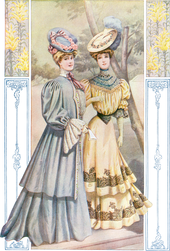Chiffon(French:[ʃi.fɔ̃];English:/ʃɪˈfɒn/,shif-ON,from the French wordchiffewhich means "cloth or rag";[1]is a lightweight, balancedplain-wovensheerfabric,or gauze, likegossamer,woven of alternateS- and Z-twistcrepe (high-twist) yarns.[2][3]Crepeyarntends to have a tighter twist than standard yarns.[1]The twist in the crepe yarns puckers the fabric slightly in both directions after weaving, giving it some stretch and a slightly rough feel.



Characteristics
editChiffon is a lightweight fabric which is associated with elegance and luxury;[4]it drapes well and has a shimmery and sheer appearance.[1][4]Under a magnifying glass, chiffon resembles a fine net or mesh, which gives it some transparency.
Chiffon can be produced out of natural or synthetic fibres.[1]Silk chiffon was very expensive, and it is with the development of synthetic chiffon, such as nylon chiffon, polyester chiffon, and rayon chiffon, that chiffon became more accessible and more popular for common usage.[1][4]
Since chiffon is a light-weight fabric which frays easily, bound or Frenchseamsmust be used to stop the fabric from fraying.
Natural fibres
editEarly chiffon was made purely fromsilkand was very expensive; when used in fashion, it was associated with high status.[1]Silk chiffon displays colours beautifully since silk fibres absorb dyes well. Chiffon also drapes well, adding structure to the clothing item it is formed into.[1]Silk chiffon needs to bedry cleaned.[1]
InChina,silk chiffon made ofraw silkwas known asxiāo(Chinese:Tiêu), which was also the name of raw silk.[5]: 352
Chiffon could also be made out ofcotton.[4]
Synthetic fibres
editIn 1938, anylonchiffon was invented; this was followed by the creation ofpolyesterchiffon in 1958, which became immensely popular due to its resilience and low cost.[1]
Usage
editIn modern Western fashion, chiffon is most commonly used in evening wear, especially as an overlay, for giving an elegant and floating appearance to thegown.[1]It is also a popular fabric used inblouses,ribbons,scarves andlingerie.[1]
InIndia,Chiffon is primarily used to makeSareesanddupattas.[1]
Similar items
editChiffon is smoother and more lustrous than the similar fabricgeorgette.[4]
Chiffon is more flowing and airy when drape than organza which is stiffer.
Chiffon is more moveable and flimsy while Tulle is more firm with a mesh type appearance.
See also
editReferences
edit- ^abcdefghijklm"What Is Chiffon Fabric? Learn About the Characteristics of This Luxury Fabric and How Chiffon Is Made".Masterclass.com.MasterClass. 2021-08-12.
{{cite web}}:CS1 maint: others (link) - ^Kadolph, Sara J., ed.:Textiles,10 th edition, Pearson/Prentice-Hall, 2007,ISBN0-13-118769-4,p. 230.
- ^28 Types of Fabrics and Their UsesMasterClass
- ^abcde"What is Chiffon? Luxury Fabric Vs Thrifty Synthetic | Contrado".Contrado Blog.2017-12-15.Retrieved2022-08-12.
- ^History of textile technology of ancient China.Weiji Cheng. Rego Park, NY: Science Press New York. 1992.ISBN1-880132-02-8.OCLC26813079.
{{cite book}}:CS1 maint: others (link)
External links
edit- Media related toChiffon (fabric)at Wikimedia Commons